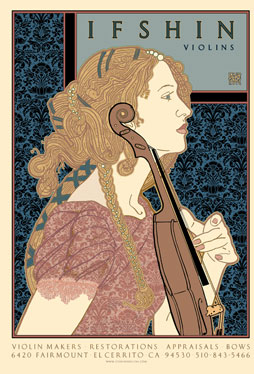
Click on image for detail
(236) Ifshin Violins:
Edition of 1724 of which 125 copies are signed 1-125, 27 copies are signed A-Zz as artist's proofs, 32 are signed as dedication copies. Three sets of progressives.Edition of 1724 of which 125 copies are signed 1-125, 27 copies are signed A-Zz as artist's proofs, 30 are signed as dedication copies. Three sets of progressives.
June 23, 2014
17-1/2" x 24"
10 Colors
Paper: Mohawk Superfine 100 lb. Cover
Influence: "Portrait of a Young Woman (Simonetta Vespucci)" Sandro Boticelli, circa 1485
Model: Claire Nicole Stremple
Client: Ifshin Violins
1-125: Saint Hieronymus Press
A-Zz: Artist's own use
Dedication copies: James Gu, Steve Pinto, Artur Friedhoff, Haide Lin, Biao Zhang, Daniel Ho, Colin Shipman, Alicia Castaneda, Richard Ward, Raphael Gold, Vivian Rogers, Felicity McCarthy, Debbie Dare, Ann Jefferson, Robert Cohea, Mia Bella D'Augelli, Brad Kline, John Ettinger, Sue Walters, Jay & Leslie Ifshin, Sonny Ifshin, John & Nancy Young, Colleen Johnson, David McCarthy, Sue & Brett, Faye & Blake, Dee Dee Batterman, Alex Segal, Erin Allard, Claire Nicole Stremple, Phil & Barbara Stremple, Jim Storey, Larry McSpadden, Wu Zhu Liang, Emily Packard
Progressives: 1 set to Saint Hieronymus Press, 1 set to Jay Ifshin, 1 set to Claire Nicole Stremple
Music is a form of speech and may well have evolved with it. Like speech, music is sound and silence working together. These intervals are gathered by our complexly-shaped ears and passed on to the brain for interpretation. Sound is what occurs all around us, but music is sound made orderly to convey a message.
Noise is what we do not understand; signal is what we do understand. Music and speech are signal winnowed from noise. Both music and speech are culturally bound: a foreign language is unintelligible noise to a non-speaker, and foreign music is often equally incomprehensible. We have to learn to understand speech and to speak, and we have to learn to understand a musical vocabulary.
With the invention of writing, speech could be preserved in a new dimension, and the limitations of time and space were circumvented: speech did not die with the speaker, nor cease when he ceased speaking. Musical notation grants that same favor to the otherwise ephemeral expression of song and rhythm, and furthermore enables far more complex expressions: I cannot imagine an oral tradition preserving Claudio Monteverdi's 1610 composition Vespro della Beata Vergine, for example.
Writing expands speech: we have active vocabularies, which are words we use, as well as passive vocabularies, which are words that we do not use but understand well enough within context. Recorded music expands us in the same way: we can make a relatively small amount of music ourselves, but understand vast amounts which we could not possibly make. Furthermore, music is taking a new turn: music is composed which cannot be performed live, and it can be assembled out of parts that may not even be recognizable musical instruments. Karlheinz Stockhausen's 1958 electronic tape-piece Kontakte, exists as a recording only.
We are entering a new world, united rather than divided by language, with all the world's music at our ears. Listen up.